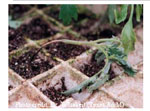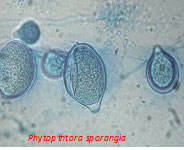Download PDF (PLPA-106)
 Getting ready for the upcoming growing season… Start seeds …They’re up and growing… Hurrah!!!…Whoa! It flopped over…It’s dead!!! What just happened??? This is typically due to a disease caused by fungal agents commonly known as “DAMPING OFF”.
Getting ready for the upcoming growing season… Start seeds …They’re up and growing… Hurrah!!!…Whoa! It flopped over…It’s dead!!! What just happened??? This is typically due to a disease caused by fungal agents commonly known as “DAMPING OFF”.
Several different fungi can cause this disease. Among the most common are Pythium sp., Phytophthora sp., and Rhizoctonia sp. These fungi love to attack young succulent tissue of plants when they are slow to grow.
SYMPTOMS
Typical symptoms occur soon after plant germinates. This can occur very quickly and appear to start at the base of the seedling. It may begin with a water-soaked appearance before progressing to becoming a constricted darken region. While seedling tops may still be green, they tend to flop over due to the loss of structural integrity. This is sometime associated with rotted roots. These plants will die. Sometimes these fungi can attack the germinating seedling before they emerge resulting in a what appear to be poor germination rate. But upon closer inspection, you might find rotten tiny seedling on the surface of the soil.
Fungi which cause damping off can be found in most soil where they can survive for long  periods of time. Give the opportunity to attack a susceptible and succulent seedling, they will result in damping off. Conditions that are most conducive to damping off are usually cool and wet, and seedling are struggling.
periods of time. Give the opportunity to attack a susceptible and succulent seedling, they will result in damping off. Conditions that are most conducive to damping off are usually cool and wet, and seedling are struggling.
MANAGEMENT
Prevention is the best approach to this problem because plants will die when symptoms are observed. Some simple approaches can help to avoid this problem: a vigorous seedling spends less time being susceptible, an older seedling is stronger to withstand damping off, and the fungi love water! In practical terms:
- Plant when soil temperatures are conducive to quick germination and growth.
- Do NOT overwater. Ensure proper drainage.
- Use sterile seed starting media, if starting seeds indoors. Do not leave media on wet ground as fungi may find their way into it.
- Remove and destroy diseased seedling immediately when disease is observed.
- Many seeds are chemically treated to prevent this problem (Noticed the red or blue color of the seeds you bought?)
Occasionally chemical treatment may be warranted when plant are in the ground. Contact your local County Extension office (http://AgriLifeExtension.tamu.edu/county) for additional assistance.
Prepared by Dr. Kevin Ong
Assistant Professor and Extension Urban Plant Pathologist
Texas AgriLife Extension Service; The Texas A&M University System
Rev. February 23, 2008
The information given herein is for educational purposes only. References to commercial products or trade names are made with the understanding that no discrimination is intended and no endorsement by Texas AgriLife Extension Service personnel is implied.
Educational programs of the Texas AgriLife Extension Service are open to all people without regard to race, color, sex, disability, religion, age, or national origin.
The Texas A&M University System, U.S. Department of Agriculture, and the County Commissioners Courts of Texas Cooperating
